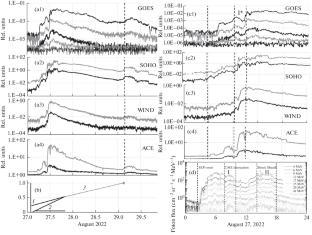Some Features of the Solar Proton Event of August 27, 2022
IF 0.48
Q4 Physics and Astronomy
Bulletin of the Russian Academy of Sciences: Physics
Pub Date : 2025-07-15
DOI:10.1134/S1062873825711262
引用次数: 0
Abstract
The solar proton event of August 27, 2022, was recorded by spacecraft near the Earth, as well as by the Parker Solar Probe spacecraft located at 0.38 AU from the Sun. During this event, a rare phenomenon was observed, namely, the acceleration of protons to energies of tens of MeV in interplanetary space, presumably, between the converging shock fronts. An unusual delay was also observed in the fluxes of solar protons with energies above 10 MeV as measured by satellites in Earth orbit in comparison with the proton fluxes measured by spacecraft at the L1 Lagrange point.

2022年8月27日太阳质子事件的一些特征
2022年8月27日的太阳质子事件是由地球附近的航天器以及距离太阳0.38天文单位的帕克太阳探测器记录下来的。在这一事件中,观察到一种罕见的现象,即质子在行星际空间加速到几十MeV的能量,可能是在收敛的激波锋面之间。与航天器在L1拉格朗日点测量的质子通量相比,在地球轨道上卫星测量的能量在10兆电子伏以上的太阳质子通量也观察到不寻常的延迟。
本文章由计算机程序翻译,如有差异,请以英文原文为准。
求助全文
约1分钟内获得全文
求助全文
来源期刊

Bulletin of the Russian Academy of Sciences: Physics
Physics and Astronomy-Physics and Astronomy (all)
CiteScore
0.90
自引率
0.00%
发文量
251
期刊介绍:
Bulletin of the Russian Academy of Sciences: Physics is an international peer reviewed journal published with the participation of the Russian Academy of Sciences. It presents full-text articles (regular, letters to the editor, reviews) with the most recent results in miscellaneous fields of physics and astronomy: nuclear physics, cosmic rays, condensed matter physics, plasma physics, optics and photonics, nanotechnologies, solar and astrophysics, physical applications in material sciences, life sciences, etc. Bulletin of the Russian Academy of Sciences: Physics focuses on the most relevant multidisciplinary topics in natural sciences, both fundamental and applied. Manuscripts can be submitted in Russian and English languages and are subject to peer review. Accepted articles are usually combined in thematic issues on certain topics according to the journal editorial policy. Authors featured in the journal represent renowned scientific laboratories and institutes from different countries, including large international collaborations. There are globally recognized researchers among the authors: Nobel laureates and recipients of other awards, and members of national academies of sciences and international scientific societies.
 求助内容:
求助内容: 应助结果提醒方式:
应助结果提醒方式:


